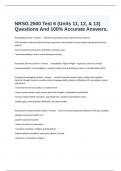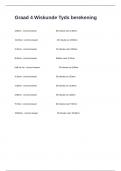NRSG 2500 Test 6 (Units 11, 12, & 13)
Questions And 100% Accurate Answers.
Neurological review - Answer -CNS-brain and spinal cord (central nervous system)
-PNS-includes cranial and spinal nerves; autonomic and somatic nervous systems (peripheral nervous
system)
-basic functional unit-neuron; dendrites, cell body, axon
*neurotransmitters used to comm between neurons
Autonomic Nervous System - Answer -sympathetic-"fight or flight" responses; main nt is norepi
-parasympathetic-"rest and digest"; controls mostly visceral functions; main nt is acetylcholine (ACh)
Assessing neurological function - Answer -cerebral function-mental status, intellectual-cognition
function, thought content, emotion status, language ability, impact on lifestyle, LOC, perception, motor,
and speech
-cranial nerves-sensory, motor, or mixed nerves
-motor system-posture, gait, muscle tone and strength, coordination and balance
-sensory system-tactile sensation, superficial pain, vibration and position sense
-reflexes-gag, corneal plantar (Babinski), and deep tendon
Assessment of altered mental status - Answer -LOC is the most important indicator of the pts condition
-glasgow coma score (GCS) 3-15
-pupils-round and reactive
-motor-symmetry vs asymmetry
-sensation-numbness, tingling, painful stimuli
-speech-aphasia (receptive, expressive, global), slurred
-voluntary vs involuntary reflexes
,Cranial Nerves - Answer -Oh Oh Oh To Touch And Feel Virgin Girls Vaginas Ah Heaven
-Some Say Marry Money, But My Brother Says Big Brains Matter More
Olfactory Nerve I - Answer -sensory
-sense of smell
Optic Nerve II - Answer -sensory
-visual acuity and fields
Occulomotor Nerve III - Answer -motor
-muscles that move the eye and lid, pupillary constriction, lens accomodation
Trochlear Nerve IV - Answer -motor
-muscles that move the eye
Trigeminal Nerve V - Answer -both/mixed
-facial sensation, corneal reflex, mastication
Abducens Nerve VI - Answer -motor
-muscles that move the eye
Facial Nerve VII - Answer -both/mixed
-facial expression and muscle movement, salivation, tearing, taste
Vestibulocochlear Nerve VIII - Answer -sensory
-hearing/equilibrium
Glossopharyngeal Nerve IX - Answer -both/mixed
-taste, swallowing
, Vagus Nerve X - Answer -both/mixed
-muscles of pharynx, larynx, sensation in external ear; pharynx, larynx, thoracic, and abdominal viscera;
parasympathetic innervations of thoracic and abdominal organs
(Spinal) Accessory Nerve XI - Answer -motor
-sternocleidomastoid and trapezius muscles
Hypoglossal Nerve XII - Answer -motor
-movement of the tongue
LOC - Answer -LOC is a continuum from normal alertness and full cognition (consciousness) to coma
(pg. 693, table 11-3)
-altered LOC is not the disorder but the result of a pathology
-coma-unconsciousness, unarousable, unresponsiveness
-akinetic mutism-unresponsiveness to the envt, makes no movement or sound, but sometimes opens
eyes
-persistent vegetative state (irreversible coma)-devoid of cognitive function but has sleep-wake cycles,
swallow, cough, and eye movement
-locked in syndrome-alert and aware, but inability to move or respond except for eye movements due to
a lesion affecting the pons, comm by blinking
-brain death-cessation and irreversibility of all brain functions, including brainstem
Monro-Kellie Hypothesis - Answer -space is limited inside the skull
*an increase in one requires a decrease in another, without compensation an elevated ICP may result
*normal circumstances-coughing, sneeze, and straining increase ICP
Intracranial autoregulation - Answer -the compensatory mechanism that allows the brain's ability to
change the diameter of the blood vessels to maintain a constant cerebral blood flow during alterations in
systemic bp
-this mechanism can be impaired in pts who are experiencing a pathological and sustained increased in
ICP





